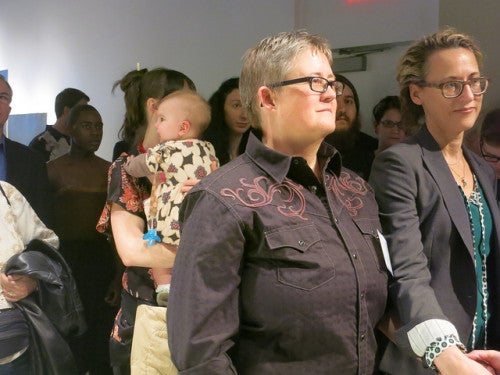
Two weeks after the removal of an artwork from the opening exhibition of the Zuckerman Museum of Art at Kennesaw State University, an agreement has been reached between KSU officials and the artist Ruth Stanford.
The censoring of Stanford’s work, first announced on February 28 by BURNAWAY and Creative Loafing, garnered national media attention. Local TV crews were on site at the opening, and stories have appeared in numerous online and print publications, including the Huffington Post, Chronicle of Higher Education, Inside Higher Ed, Artnet News, Artinfo.com, and ArtLeaks.
On March 5, KSU officials agreed to reinstate Stanford’s work, but she had reservations about how the work’s meaning had been altered and was concerned that viewers’ expectations and assumptions would have shifted. She resisted the administration’s wish to have explanatory materials incorporated in or available near her work, and considered declining its offer.
According to a join press statement issued today, the museum staff and the artist have begun reinstalling the multi-part work. It will be on view “no later than March 25” and will remain on view for the duration of the exhibition, which closes April 26.
Stanford told BURNAWAY that, while she’s delighted the work will be on view again, “we had difficulty over the wording “ of the joint statement, and she felt rushed and pressured to give her consent. She has not received a formal apology.
The press statement continues:
“Campus officials also will provide explanatory materials and host public programs that address the complexity and controversial nature of the subject matter: Georgia writer Corra Harris—whose homestead was gifted to the University in 2008—and a letter she wrote in 1899 on the topic of lynching.
Kennesaw State University officials also reaffirm the administration’s full support of academic freedom and for the free exchange of ideas. Our intention is to use this entire experience as a learning and engagement opportunity for all of our stakeholders.”
The university thanked Stanford for remaining involved in a dialogue with officials and for her thoughtful consideration of the matter. Details on the supplemental programming will be announced once plans are finalized.
Stanford’s statement says:
“While Kennesaw State’s administration and I continue to disagree on certain issues related to the removal of my work, “A Walk in the Valley,” from the Zuckerman Museum of Art, we have come to agree that the work should be restored to its place in the exhibition.
This has been a difficult experience, but I hope that the conversations it has generated about art, place, history, academic freedom, and free speech have been, and will continue to be, productive.
I am proud to be included in the See Through Walls exhibition alongside a number of amazing artists, and I look forward to supporting the work of the ZMA moving forward.”
With a tone of resignation and disconsolation in her voice, Stanford told BURNAWAY: “In the end, the bigger question is about why the university is not willing to talk about the censorship of my work. I wish they’d be more open.”







